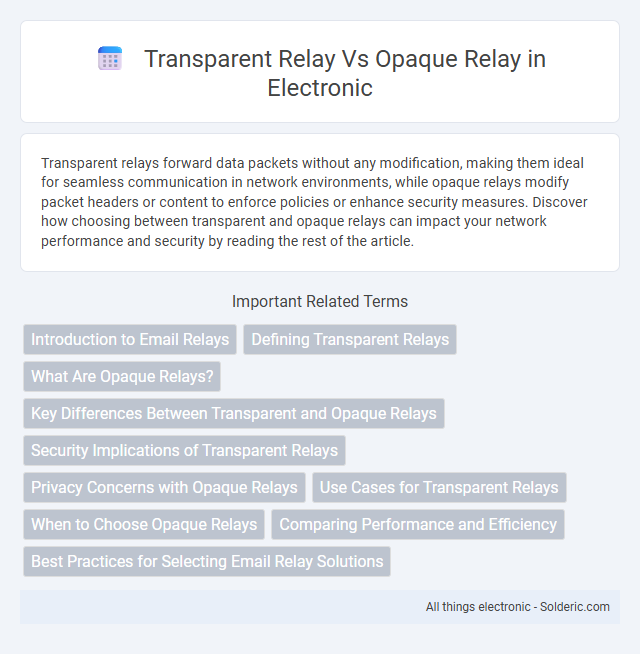Transparent relays forward data packets without any modification, making them ideal for seamless communication in network environments, while opaque relays modify packet headers or content to enforce policies or enhance security measures. Discover how choosing between transparent and opaque relays can impact your network performance and security by reading the rest of the article.
Comparison Table
| Feature | Transparent Relay | Opaque Relay |
|---|---|---|
| Definition | Relay that forwards signals without modifying or encrypting data. | Relay that modifies or encrypts data to provide privacy or security. |
| Data Visibility | Data is fully visible and accessible during transmission. | Data is hidden or encrypted, preventing direct access. |
| Use Case | Simple forwarding, extending signal range, or network bridging. | Privacy-sensitive communication, secure data transmission. |
| Security Level | Low; no additional security applied. | High; ensures confidentiality and integrity. |
| Complexity | Lower complexity, easier to implement. | Higher complexity due to encryption or transformation. |
| Latency Impact | Minimal latency added. | Potentially higher latency due to data processing. |
Introduction to Email Relays
Email relays facilitate the transfer of email messages between servers, playing a crucial role in ensuring successful delivery. Transparent relays forward emails without altering the original sender information, maintaining the authenticity of the message path. Opaque relays modify or mask sender details, often used to obscure source information for privacy or security purposes, but they may increase the risk of spam filtering or delivery issues.
Defining Transparent Relays
Transparent relays operate by forwarding emails without modifying the original message headers, allowing them to function seamlessly between mail servers and clients. They preserve the sender's information and support authentication mechanisms like SPF and DKIM, enhancing email security. Unlike opaque relays, which alter or obscure sender details, transparent relays maintain message integrity for reliable email delivery and filtering.
What Are Opaque Relays?
Opaque relays hide the original sender's IP address and other identifying details by replacing them with the relay server's information, enhancing privacy and security during email transmission. Unlike transparent relays that forward emails without altering header information, opaque relays modify routing data, making it difficult to trace the message back to your original server. This makes opaque relays particularly useful for organizations aiming to protect internal network details while ensuring reliable email delivery.
Key Differences Between Transparent and Opaque Relays
Transparent relays forward email messages without altering the sender's information, making them suitable for simple mail routing but vulnerable to spoofing attacks. Opaque relays, on the other hand, modify the sender's metadata to hide the original source, enhancing security by preventing unauthorized email spoofing. Your choice between transparent and opaque relays depends on the balance between security needs and maintaining original sender details for email tracking.
Security Implications of Transparent Relays
Transparent relays forward traffic without modifying packet headers, making them susceptible to interception, unauthorized data access, and man-in-the-middle attacks due to lack of authentication mechanisms. Opaque relays, by contrast, obscure routing information and employ encryption, enhancing privacy and reducing risks of traffic manipulation or eavesdropping. Networks using transparent relays must implement additional security measures such as strict access controls, encryption protocols, and monitoring to mitigate vulnerabilities inherent in their design.
Privacy Concerns with Opaque Relays
Opaque relays pose significant privacy concerns because they obscure the data path, making it difficult to verify the data's integrity and origin. Users cannot easily detect potential tampering or eavesdropping since the relay hides the intermediate hops, increasing the risk of data interception and unauthorized access. In contrast, transparent relays provide greater visibility and control, enhancing trust and security in data transmission.
Use Cases for Transparent Relays
Transparent relays are primarily used in network environments that require seamless packet forwarding without modifying the content or routing decisions, such as in security gateways or load balancing scenarios. They excel in use cases where minimal interference is necessary, including traffic monitoring, intrusion detection systems, and protocol conversion. These relays support efficient data flow while preserving the integrity and transparency of the transmitted information.
When to Choose Opaque Relays
Opaque relays are preferred when maintaining strict control over email flow and enforcing advanced security policies without exposing internal infrastructure details is crucial. They enable seamless integration with existing mail servers while supporting sophisticated filtering, logging, and authentication mechanisms. Organizations handling sensitive data or requiring strong compliance measures benefit from opaque relays to enhance protection against spam, phishing, and unauthorized access.
Comparing Performance and Efficiency
Transparent relays operate by forwarding packets without modifying them, resulting in lower latency and reduced processing overhead, which enhances network efficiency. Opaque relays, by contrast, analyze and sometimes alter packet data, introducing higher processing delays but offering greater control and error handling. Performance in transparent relays excels in speed and minimal resource usage, while opaque relays prioritize robust functionality at the cost of increased computational effort.
Best Practices for Selecting Email Relay Solutions
Choosing between Transparent Relay and Opaque Relay hinges on security needs and email flow control; transparent relays provide visibility and easier troubleshooting by passing email headers unchanged, while opaque relays enhance privacy by masking sender information. Best practices involve assessing compliance requirements, ensuring proper authentication (SPF, DKIM, DMARC), and balancing transparency for monitoring against anonymity for security. Enterprises should implement relay solutions that align with their risk tolerance, infrastructure complexity, and regulatory mandates to optimize email deliverability and protect against spoofing and phishing.
Transparent Relay vs Opaque Relay Infographic

 solderic.com
solderic.com